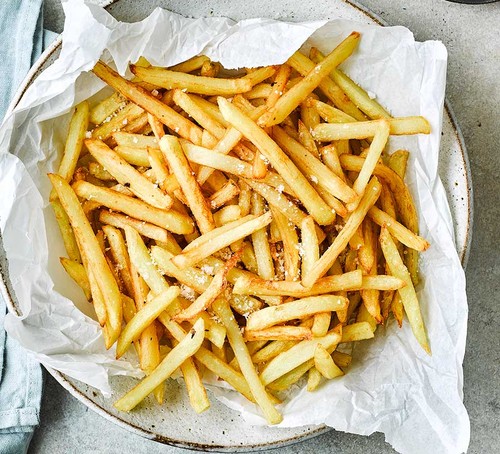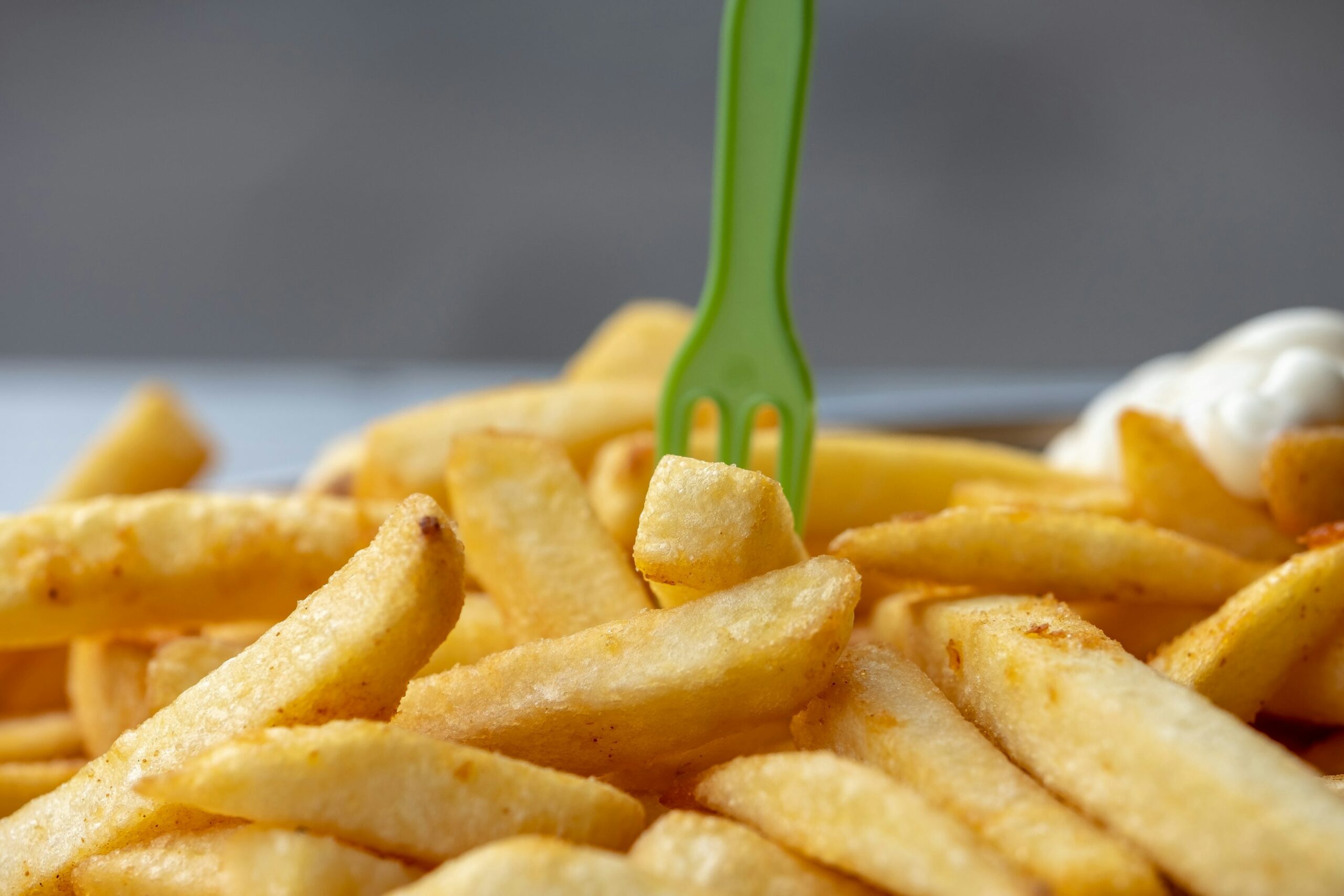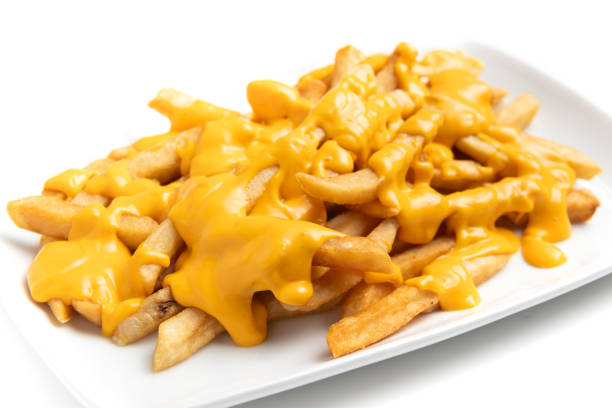Introduction
French fries are more than just a side dish; they’re a global phenomenon, a comfort food that evokes memories of drive-thrus, beachside stands, and family dinners. But nothing beats the satisfaction of making them at home. Homemade French fries offer unparalleled crispiness, freshness, and customization that fast-food chains simply can’t match. Whether you’re dipping them in ketchup, sprinkling them with sea salt, or loading them up with cheese and toppings, the perfect fry starts with quality ingredients and a few key techniques.
In this comprehensive guide, we’ll dive deep into everything you need to know about crafting the ultimate homemade French fries. From their fascinating history to step-by-step instructions, tips for perfection, common pitfalls to avoid, exciting variations, serving ideas, and even nutritional insights, this article is your one-stop resource. If you’re new to frying or a seasoned home cook, you’ll find valuable advice here to elevate your game.

Why go homemade? Store-bought frozen fries are convenient, but they often contain preservatives, excess sodium, and unhealthy oils. Making them yourself allows control over the oil type (like heart-healthy canola or avocado oil), portion sizes, and flavors. Plus, it’s cost-effective – a few potatoes can feed a crowd for pennies compared to restaurant prices. According to various recipes, the key to success lies in selecting the right potatoes, proper cutting, soaking, and double-frying for that irresistible crunch.
We’ll also incorporate links to related content on our site, such as our guide to potato-based appetizers, and external resources for further reading. By the end, you’ll be equipped to create fries that rival any gourmet kitchen. Let’s get started on this crispy adventure!
The History of French Fries: From Humble Beginnings to Worldwide Staple
The story of French fries is as layered as the potato itself, filled with debates, cultural claims, and culinary evolution. Contrary to their name, French fries may not be French at all. Historians often point to Belgium as the true birthplace. In the late 17th century, villagers in the Meuse Valley of Belgium fried small fish as a staple. During harsh winters when the river froze, they turned to potatoes – introduced to Europe by Spanish explorers from South America – slicing and frying them as a substitute.
Pierre Leclercq, a Belgian food historian, asserts that fries are unequivocally of French origin, but evidence suggests otherwise. The first recorded mention appears in a 1775 Parisian book, but Belgian lore dates them to 1680 in Namur. The name “French fries” likely stems from American soldiers during World War I, who encountered them in French-speaking Belgium and dubbed them “French.”
Thomas Jefferson played a pivotal role in bringing fries to America. As U.S. ambassador to France, he enjoyed “potatoes served in the French manner” and introduced them at a White House dinner in 1802. By the 19th century, street vendors in Paris sold them from Pont Neuf bridge, solidifying their popularity.
The industrial era transformed fries. In the 1920s, automated peelers and cutters made mass production possible, leading to fast-food empires like McDonald’s in the 1940s. Today, fries are a $20 billion industry, with variations worldwide – from poutine in Canada to masala fries in India.
This history underscores why homemade versions honor the original simplicity: just potatoes, oil, and salt. For more on food origins, check our blog on historical recipes.
Ingredients for Homemade French Fries
To make about 4 servings of classic homemade French fries, you’ll need simple, accessible ingredients. The star is the potato – opt for russets for their high starch content, which yields fluffy interiors and crispy exteriors.
- 4 large russet potatoes (about 2-2.5 pounds)
- Vegetable oil or peanut oil for frying (enough to fill your pot or fryer to 3-4 inches deep – about 1-2 quarts)
- Sea salt or kosher salt to taste (1-2 teaspoons)
- Optional seasonings: garlic powder, paprika, onion salt (1 teaspoon each for seasoned fries)
That’s it for the basics! For healthier options, use olive oil for baking. Ensure potatoes are fresh and firm; avoid waxy varieties like red potatoes, as they don’t crisp well.
Tools: A sharp knife or french fry cutter, large bowl for soaking, deep pot or fryer, thermometer, slotted spoon, and paper towels.
For variations, add cheese, herbs, or spices – more on that later. Link to our ingredient buying guide.
Step-by-Step Recipe: How to Make Homemade French Fries
Making homemade French fries is an art, but with this foolproof method, you’ll achieve restaurant-quality results. We’ll focus on the double-fry technique for maximum crispiness.
- Prepare the Potatoes: Wash and peel the russets (or leave skin on for rustic fries). Cut into even 1/4 to 1/2-inch thick strips using a sharp knife or cutter for uniformity – this ensures even cooking. Aim for 3-4 inches long.
- Soak the Fries: Place cuts in a large bowl of cold water for 30-60 minutes (or up to overnight in the fridge). This removes excess starch, preventing sogginess and promoting crispiness. Change water if it clouds.
- Dry Thoroughly: Drain and pat dry with paper towels or a clean kitchen towel. Moisture is the enemy of crisp fries – any water will cause splattering and steaming instead of frying.
- First Fry (Blanching): Heat oil in a deep pot or fryer to 300-325°F (use a thermometer for accuracy). Fry in batches (don’t overcrowd) for 3-5 minutes until soft but not browned. Remove with slotted spoon and drain on paper towels. This cooks the interior.
- Second Fry (Crisping): Increase oil to 375-400°F. Fry again in batches for 2-4 minutes until golden and crispy. Watch closely to avoid burning.
- Season and Serve: Drain on fresh paper towels, season immediately with salt while hot (it sticks better). For seasoned fries, toss with garlic salt, paprika, etc.
Baking Alternative: Toss dried cuts with 2-3 tbsp oil, spread on a baking sheet, and bake at 450°F for 20-25 minutes, flipping halfway.
Total time: 1 hour (including soak). Yields crispy, fluffy fries. For video tutorials, see external links like this YouTube guide. Check our frying basics tutorial.

Tips and Tricks for Perfect Homemade French Fries
Achieving that elusive crunch requires insider knowledge. Here are expert tips compiled from top sources.
- Potato Choice: Stick to starchy russets or Yukon Golds. Avoid waxy ones.
- Cutting Hack: Use a serrated knife for easier slicing or a fry cutter for uniformity.
- Soaking Secret: Add vinegar (1 tbsp per quart water) to the soak for extra crispiness by strengthening pectin.
- Oil Temperature: Always use a thermometer. Low first fry cooks inside; high second fry crisps outside. Peanut oil has a high smoke point.
- Batch Frying: Fry in small batches to maintain oil temp. Overcrowding lowers it, leading to grease absorption.
- Post-Fry: Cool on a wire rack, not paper towels alone, to prevent sogginess from steam.
- Make-Ahead: Blanch and freeze for later crisping.
- Air Fryer Option: For healthier fries, air fry at 400°F for 15-20 minutes, shaking halfway.
Experiment with these for flawless results. For more tips, visit our kitchen hacks section.
Common Mistakes to Avoid When Making French Fries at Home
Even pros slip up, but avoiding these errors will save your fries.
- Wrong Potatoes: Using waxy varieties leads to limp fries.
- Uneven Cuts: Random sizes mean uneven cooking – some burn, others stay raw.
- Skipping Soak: Starch causes clumping and sogginess.
- Overcrowding: Drops oil temp, resulting in greasy fries.
- Incorrect Temps: Too low = soggy; too high = burnt outside, raw inside.
- Not Drying: Water causes dangerous splatters and steamy fries.
- Salting Too Early: Salt draws moisture; add after frying.
- Reusing Old Oil: Imparts off-flavors; filter or replace.
- Ignoring Double Fry: Single fry often yields soft results.
By sidestepping these, your fries will shine. See our troubleshooting guide.
Variations on Homemade French Fries
Keep things exciting with these twists.
- Cheese Fries: Top with melted cheddar or Monterey Jack, bacon, and green onions.
- Poutine: Canadian classic – fries with cheese curds and gravy.
- Sweet Potato Fries: Swap russets for sweets, bake with cinnamon.
- Curly Fries: Use a spiralizer, season with Cajun spice.
- Loaded Fries: Add chili, sour cream, jalapeños.
- Garlic Parmesan: Toss with garlic butter, parmesan, herbs.
- Peri-Peri Fries: Spicy African seasoning with cheese.
- Truffle Fries: Drizzle truffle oil, grate parmesan.
- Waffle Fries: Cut crosshatch pattern, fry crisp.
- Masala Fries: Indian spices like cumin, chili powder.
These add flair. Try our variation recipes.

Serving Suggestions for Your Homemade French Fries
Fries shine as sides but can star too.
- Classic Pairings: With burgers, hot dogs, or fried chicken.
- Dips: Ketchup, aioli, ranch, or truffle mayo.
- Loaded Boards: Build a fry bar with toppings like guac, salsa.
- Fusion: With curry, kimchi, or tzatziki.
- Main Dishes: Fry bowls with mac ‘n’ cheese, pulled pork.
- Elegant: With steak or seafood, drizzled in herbs.
Serve hot for best texture. See our pairing ideas.
Nutritional Information
Homemade fries can be healthier than fast-food. A 100g serving has about 196 calories, 13g fat, 18g carbs, 2g protein, and 141mg sodium. Baking reduces fat to 7-8g per serving.
Potatoes provide vitamin C, potassium, fiber. Control portions; air-frying cuts calories by 70%. For full breakdown, consult USDA database.
FAQs About Homemade French Fries
Q: How long do fries last? A: Best fresh, but store in fridge up to 2 days; reheat in oven.
Q: Can I freeze them? A: Yes, after blanching; fry from frozen.
Q: Why are my fries soggy? A: Likely skipped soaking or overcrowded.
Q: Best oil? A: Peanut or canola for high smoke point.
Q: Oven vs. fry? A: Frying crispier, oven healthier.
More in our FAQ section.
Conclusion
Mastering homemade French fries is rewarding, blending history, science, and creativity. With the right techniques, you’ll create addictive treats. Experiment, share, and enjoy! For more recipes, visit our home page.